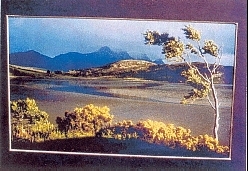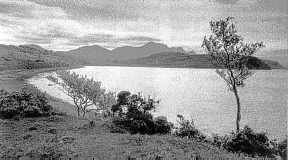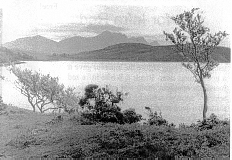COBBLER'S PAGE By Brian Asquith (Librarian) We had a short holiday in Scotland a few weeks ago, a trip to the North to Lairg, Tongue and John Ď0 Groats. We were taking in the places we visited several times in the past, the last time over twenty years ago. So there we were in Tongue with cameras ready and the weather nice and sunny. I decided that I would try to repeat a successful picture I had taken all those years ago. First find the viewpoint. My memory had already played me a trick in putting the Post Office on the wrong side of the road to what I remembered! However, the sea loch cannot have been moved so I make my way through the roadside gate and along through the wood to the lochside. Well the wood was considerably denser, full of gorse bushes and deep drainage channels but with determination I forced my way through to the lochside. I had remembered a tree in the foreground and a small clump of gorse adding a touch of bright colour to the scene. Just which were the ones I couldnít see because, Iím sure you will have guessed, there was a lot more of everything and it was much higher too. Still the mountains across the loch looked the same so I took what I thought was near enough. I used the folding Ensign 2.1/4 X 1.5/0 and a 35mm with a wide angle lens. Originally, 20 years ago, the picture was taken on 35mm slide and on B&W with an Ensign 3.1/4 x 2.1/4. Yes, I used to carry a lot more gear in those days. What was missing this time was the fantastic lighting. Now it was a rather flatly lit scene, then it had been a stormy sky and lovely texture on the water but I took the picture anyway. It was amazing when the results were seen how close I had been the viewpoint was almost spot on. The same tree still quite small amidst the gorse, which was much bigger and more extensive, but still recognisable as in the originals. The moral-if any-is do not expect to repeat past successes. It was an interesting and challenging exercise. I could have made it easier if I had had a copy of the original prints with me. I have a 20 x 16 of the b&w taken 20 years ago, it looks a little flat by todays standards. I do intend printing it again when I can find time to see what I have learned and how modern papers cope with the gradiation of the super Ross Express lens. The slide was printed on reversal paper (not Ciba) and is really impressive. I do hope it can be printed in the magazine. Perhaps there is scope for re-doing some of the pictures of the past given the opportunity. Looking back even further does anyone remember Marston and Heard? they used to sell bargains via The Amateur Photographer, equivalent to Exeter Photographic (Melbourne Photographic) and others who appear from time to time. However, Marston and Heard sold a film for making lantern slides. You could handle this in the darkroom under a red safelight, enlarge onto it or contact print it. Developed in a Glycin based developer it gave lovely tones. (What price glycin now?) I went to town with it resulting in a big collection of monochrome slides 2.1/4 x 2.1/4. When asked to give a talk on medium format photography to a group I said yes. Since then I have delved into the cupboard and dug out all my 2.1/4 x 2.1/4 slides. The B & W are in super condition and look really good technically and quite a lot of the coloured ones are still OK. It was an eye opener to see how the films have changed over the years. The modern Fuji, of which I have exposed five rolls, is very contrasty compared with the Agfa and Ektachrome used in the 60s and 70s. I wish I could get hold of some of the old emulsions, which covered such a range of contrasts with ease. Can anyone tell me where I can get a lantern slide film? Perhaps I should be thinking of scanning prints onto transparent film on the PC. I bet Glycin was bad for you anyway. I read the other day that after two hours in front of a PC screen you should take a break to avoid headaches. Never had this problem in the darkroom! Happy shooting, Brian. Editor: Brian sent four pictures. The two B&W as shown here and two transparencies. The one at the top scanned nicely and describes Brian's article very well but the other wouldn't scan to a useable level.
|


